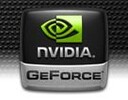Review HP Pavilion HDX 9320EG Notebook
Intel Core 2 Duo T8100 | NVIDIA GeForce 8800M GTS | 20.10" | 7 kg

The Nvidia GeForce 8800M GTS (also known as nVidia GeForce Go 8800M) is based upon the desktop G92 chip and is essentially a reduced (64 versus 96 Unified Shaders) 9800M GTX chip for DirectX 10.
The most important feature of the GeForce 8800M GTS is its use of "Unified Shaders". Dedicated pixel and vertex shaders are replaced by 64 Stream processors, which now do all the graphics workload previously handled by the two former discrete shaders. Furthermore, the Shader units are clocked higher than the core GPU itself (1250 MHz versus 800 MHz).
The performance of the 8800M GTS should be much greater than the 8700M GT because of the 256 bit wide memory bus and the higher amount of Unified Shaders. Most games of 2007 should run fluently on high detail settings, save for intensive titles such as Crysis and World in Conflict. Models are available in 256 MB and 512 MB GDDR3 versions. Compared to more recent graphics cards, the 8800M GTS performs similarly to the 40nm Nvidia Geforce GTS 250M.
The current consumption and heat output will likely be higher than the 8700M GT, thus making the 8800M GTS suitable for larger notebooks with more powerful cooling solutions.
GeForce 8800M Series
| ||||||||||
| Codename | NB8E-GT | |||||||||
| Architecture | G9x | |||||||||
| Pipelines | 64 - unified | |||||||||
| Core Speed | 500 MHz | |||||||||
| Shader Speed | 1250 MHz | |||||||||
| Memory Speed | 800 MHz | |||||||||
| Memory Bus Width | 256 Bit | |||||||||
| Memory Type | GDDR3 | |||||||||
| Max. Amount of Memory | 512 MB | |||||||||
| Shared Memory | no | |||||||||
| API | DirectX 10, Shader 4.0 | |||||||||
| Power Consumption | 50 Watt | |||||||||
| Transistor Count | 754 Million | |||||||||
| technology | 65 nm | |||||||||
| Features | 1250 MHz Shader clock, probably: PureVideo technology (H.264, VC-1, MPEG2, WMV9 decoder acceleration), HDCP-capable, PowerMizer 7.0 energy management (dynamic switching between performance and energy saving), HDR (high dynamic-range lighting), designed for Windows Vista, Dual-Link DVI-D exits for resolutions from TFT up to 2560x1600, PCI-E 16x, OpenGL 2.1, Gigathread technology | |||||||||
| Notebook Size | large | |||||||||
| Date of Announcement | 19.11.2007 | |||||||||
| Information | MXM Faktor III | |||||||||
| Link to Manufacturer Page | www.nvidia.com | |||||||||
The following benchmarks stem from our benchmarks of review laptops. The performance depends on the used graphics memory, clock rate, processor, system settings, drivers, and operating systems. So the results don't have to be representative for all laptops with this GPU. For detailed information on the benchmark results, click on the fps number.
| low | med. | high | ultra | QHD | 4K | |
|---|---|---|---|---|---|---|
| Crysis - GPU Benchmark | 74.3 | 37.9 | 23.7 | |||
| Crysis - CPU Benchmark | 88.9 | 37.7 | 22.3 | |||
| World in Conflict - Benchmark | 42 | 27 | ||||
| F.E.A.R. | 31 | 27 | 26 | |||
| Doom 3 | 150.1 | 149.2 | 156.9 | 150.6 | ||
| low | med. | high | ultra | QHD | 4K | < 30 fps < 60 fps < 120 fps ≥ 120 fps | 1 2 1 | 1 3 1 | 4 1 | 1 | | |
For more games that might be playable and a list of all games and graphics cards visit our Gaming List
HP Pavilion HDX9313TX: Intel Core 2 Extreme X9000, 20.10", 8.2 kg
External Review » HP Pavilion HDX9313TX
HP Pavilion HDX9203KW : Intel Core 2 Duo T9500, 20.10", 8 kg
External Review » HP Pavilion HDX9203KW
Gateway P-6860FX: Intel Core 2 Duo T5550, 17.10", 4.2 kg
External Review » Gateway P-6860FX
HP Pavilion HDX9320EG: Intel Core 2 Duo T8100, 20.10", 7.1 kg
External Review » HP Pavilion HDX9320EG
Gateway P-6831FX: Intel Core 2 Duo T5450, 17.10", 3.8 kg
External Review » Gateway P-6831FX
Gateway P-171XL: Intel Core 2 Extreme X7900, 17.10", 4.2 kg
External Review » Gateway P-171XL
Gateway P-171S: Intel Core 2 Duo T7250, 17.10", 4.2 kg
External Review » Gateway P-171S
HP Pavilion HDX9270eg: Intel Core 2 Duo T9300, 20.10", 7 kg
External Review » HP Pavilion HDX9270eg
» Comparison of GPUs
Detailed list of all laptop GPUs sorted by class and performance.
» Benchmark List
Sort and restrict laptop GPUs based on performance in synthetic benchmarks.
» Notebook Gaming List
Playable games for each graphics card and their average FPS results.
Top 10 Laptops
Multimedia, Budget Multimedia, Gaming, Budget Gaming, Lightweight Gaming, Business, Budget Office, Workstation, Subnotebooks, Ultrabooks, Chromebooks
under 300 USD/Euros, under 500 USD/Euros, 1,000 USD/Euros, for University Students, Best Displays
Top 10 Smartphones
Smartphones, Phablets, ≤6-inch, Camera Smartphones